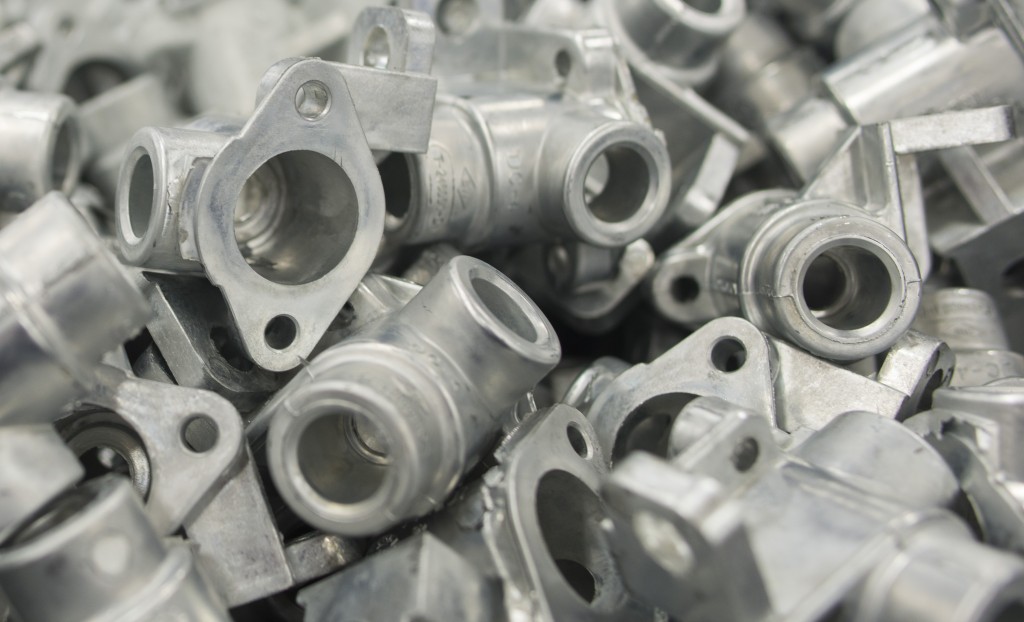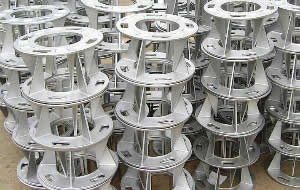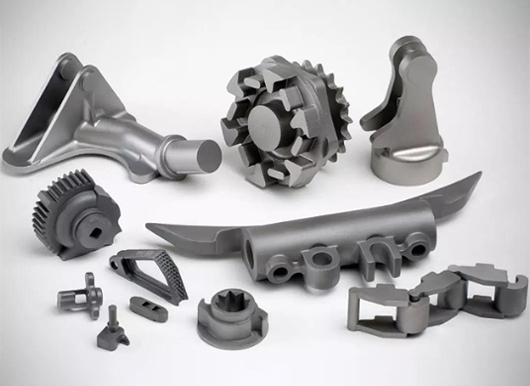Discovering the Benefits and Practical Use Aluminum Castings in Today's Market
Light weight aluminum castings have actually become significantly appropriate in various industries due to their special qualities. Their lightweight nature and resistance to corrosion make them suitable for demanding applications. In addition, the exceptional strength-to-weight ratio provides significant advantages in layout and manufacturing. As markets remain to discover their capacity, the complete scope of aluminum spreadings' applications and benefits continues to be to be fully discovered. What exists in advance for this versatile material?
The Lightweight Benefit of Aluminum Castings
Several materials are utilized in production, light weight aluminum spreadings stand out primarily due to their light-weight properties. This characteristic makes aluminum castings an eye-catching selection for different sectors, particularly in aerospace and automobile applications, where weight decrease is vital for boosting gas performance and performance. The lightweight nature of light weight aluminum permits makers to produce components that are simpler to set up and manage, ultimately reducing labor prices.
The ability to generate complex forms without substantial weight fines allows developers to innovate while preserving structural honesty. Light weight aluminum castings can effectively replace larger products, resulting in significant savings in delivery and functional costs. Their light-weight advantage also adds to improved product long life, as lighter parts commonly result in reduced damage on machinery. Generally, the lightweight homes of aluminum spreadings offer producers with a competitive side, promoting developments in item layout and efficiency across various fields.

Outstanding Corrosion Resistance
Light weight aluminum spreadings have an all-natural resistance to oxidation, which considerably improves their longevity in various settings. This integral residential property not only adds to their sturdiness however likewise aligns with the light-weight benefit that aluminum offers. Therefore, light weight aluminum castings are significantly acknowledged for their exceptional rust resistance in various applications.

Normally Resistant to Oxidation
One of the standout characteristics of light weight aluminum spreadings is their outstanding rust resistance, which stems from an all-natural oxidation process. When subjected to air, light weight aluminum responds to develop a thin, protective layer of light weight aluminum oxide. This layer functions as an obstacle against more oxidation and shields the underlying metal from harsh components such as moisture and salts. Unlike various other metals, this oxide layer is self-repairing; if harmed, it quickly reforms when revealed to air. This one-of-a-kind property boosts the durability of aluminum castings in different settings, making them suitable for applications in markets such as aerospace, auto, and marine. Subsequently, the natural resistance to oxidation substantially minimizes upkeep prices and enhances the integrity of light weight aluminum castings popular conditions.
Light-weight Sturdiness Benefit
The lightweight nature of aluminum castings adds significantly to their durability, making them a helpful choice in different sectors. This outstanding durability is mainly connected to light weight aluminum's innate resistance to rust, which is boosted further with anodizing and various other surface area therapies. Unlike many metals, light weight aluminum does not corrosion; rather, it develops a safety oxide layer that guards it from environmental damage. This building is specifically helpful in sectors such as automobile and aerospace, where weight reduction is important without endangering stamina. In addition, the durability of aluminum castings reduces upkeep prices and substitutes, giving financial advantages gradually. Their light-weight durability and deterioration resistance position aluminum spreadings as an exceptional material for modern manufacturing applications.

Superior Strength-to-Weight Ratio
An amazing characteristic of light weight aluminum castings is their exceptional strength-to-weight proportion, that makes them highly preferable in various applications. This inherent building enables aluminum spreadings to stand up to considerable tension while continuing to be light-weight, a critical consider sectors such as aerospace, vehicle, and production. Designers commonly like aluminum castings for elements that require both sturdiness and decreased weight, improving fuel performance and efficiency.
The high strength-to-weight proportion likewise helps with the design of intricate shapes and frameworks, making light weight aluminum spreadings versatile for complex applications. The ability to preserve architectural stability under challenging problems assurances durability and reliability in items, from aircraft structures to vehicle components. This benefit adds to the growing fad of using light weight aluminum spreadings in innovative styles, inevitably leading to enhanced performance and effectiveness throughout diverse industries. As a result, the superior strength-to-weight proportion of aluminum castings positions them as a pivotal product in modern design and production.
Cost-Effectiveness in Production
Cost-effectiveness in aluminum spreading production is largely achieved with lowered product waste and reliable production procedures. By optimizing designs and making use of advanced methods, suppliers can minimize excess material use while maintaining quality requirements. This strategy not just lowers production prices yet also adds to extra lasting practices within the market.
Lowered Material Waste
Decreasing material waste in light weight aluminum spreading processes substantially enhances production performance. By optimizing the layout and production strategies, firms can minimize excess scrap and enhance source use. This decrease in waste not only lowers product costs yet likewise adds to a much more lasting production version. The capacity to reuse light weight aluminum more assistances cost-effectiveness, permitting suppliers to redeem and recycle products without endangering top quality. As the market progressively concentrates on sustainability, minimized product waste straightens with ecological objectives while simultaneously enhancing productivity. Inevitably, effective use basic materials strengthens the competitive position of businesses in the marketplace, making light weight aluminum castings a favorable choice in different applications. The tactical technique to reducing waste reflects a dedication to both financial and eco-friendly duty.
Effective Manufacturing Processes
While standard manufacturing procedures can incur significant costs, light weight aluminum casting offers an extra efficient option that improves overall production success. This method minimizes product waste and enables precise control over the manufacturing process, leading to minimized labor and operational prices. The capability to produce complicated shapes with fewer steps further simplifies manufacturing, adding to shorter preparations. Furthermore, aluminum's lightweight nature and excellent thermal conductivity permit power savings during manufacturing and in the final application. By using modern casting modern technologies, manufacturers can accomplish greater throughput without sacrificing quality. Subsequently, aluminum casting attracts attention as an economical remedy, making it an attractive option for services aiming to optimize their production procedures in today's open market.
Flexibility Across Industries
Light weight aluminum spreadings show remarkable convenience throughout numerous markets, as they can be customized to satisfy certain needs and applications. In the auto sector, light weight aluminum spreadings are used in engine blocks, transmission real estates, and wheels, offering light-weight yet resilient remedies that enhance gas performance. The aerospace market also gains from light weight aluminum castings, using them in structural elements and engine components due to their strength-to-weight proportion.
In the durable goods market, manufacturers employ aluminum spreadings for items varying from cooking equipment to furniture, offering both visual appeal and functionality. The electronic devices industry utilizes aluminum castings for housings and warm sinks, ensuring efficient thermal management. Additionally, the construction sector leverages light weight aluminum spreadings for architectural parts and building elements, enhancing resilience and layout versatility. This broad applicability highlights light weight aluminum castings as a necessary resource, satisfying the varied demands of numerous markets while keeping high performance and reliability.
Sustainability and Environmental Impact
As sectors significantly focus on sustainable techniques, aluminum castings become a green Visit Website selection because of their recyclability and low environmental footprint. Light weight aluminum is among one of the most recycled products globally, with the capacity to be repurposed several times without destruction of top quality. This particular greatly lowers the demand for raw materials and power usage linked with main light weight aluminum manufacturing, which is energy-intensive.
Additionally, light weight aluminum castings add to lightweight styles, bring about fuel effectiveness in transport applications such as automotive and aerospace industries. Their resilience and resistance to rust expand product life expectancies, further decreasing waste and resource use with time. Additionally, several manufacturers are taking on accountable sourcing and eco-friendly manufacturing methods, enhancing the sustainability of light weight aluminum spreading processes. On the whole, light weight aluminum spreadings stand for a sensible option for organizations aiming to decrease their environmental effect while accomplishing efficiency and effectiveness.
Advancements in Light Weight Aluminum Casting Technologies
Current developments in aluminum spreading innovations have considerably improved the effectiveness and top quality of manufacturing processes. Innovations such as 3D printing and advanced mold-making methods have actually allowed manufacturers to produce elaborate styles with decreased product waste. This change not just boosts the precision of actors components yet also shortens lead times, allowing for quick prototyping and faster market entry.
Additionally, the incorporation of sophisticated computer simulations help in anticipating potential issues throughout casting, resulting in higher-quality outputs (Aluminum Foundry). The usage of light-weight alloys has likewise added to the growth of stronger, a lot more resilient items, satisfying markets varying from automobile to aerospace
Furthermore, automated casting procedures have arised, minimizing human error and increasing production speed. Collectively, these advancements are transforming the aluminum casting landscape, driving better competition and sustainability in manufacturing. As industries remain to evolve, these technologies will certainly play a necessary role in meeting future needs for effectiveness and quality.
Regularly Asked Questions
Just How Do Aluminum Castings Contrast to Various Other Steels in Terms of Thermal Conductivity?
Aluminum castings show remarkable thermal conductivity compared to several steels, such as steel and iron - Aluminum Foundry. Their lightweight nature and effective heat circulation make them perfect for applications needing efficient thermal administration in numerous markets
What Are the Common Issues Discovered in Light Weight Aluminum Castings?
Usual problems in light weight aluminum spreadings include porosity, shrinking, inclusions, and surface irregularities. These issues typically occur from inappropriate air conditioning prices, inadequate mold style, or contaminations, affecting the overall quality and efficiency of the end product.
Can Aluminum Castings Be Recycled, and Just how?
Aluminum spreadings can be recycled effectively. The procedure entails accumulating, melting, and changing the aluminum, which lessens waste and conserves sources. This reusing adds to sustainability while preserving the product's residential properties for future use.
What Are the Normal Lead Times for Aluminum Casting Manufacturing?
Normally, lead times for light weight aluminum casting manufacturing array from two to six weeks, depending upon aspects such as intricacy, tooling requirements, and manufacturing volume. Performance can improve with well-known distributor relationships and maximized production procedures.
Exactly how Does the Surface Complete Affect Light Weight Aluminum Spreading Efficiency?
The surface coating significantly influences aluminum casting efficiency by influencing corrosion resistance, aesthetic quality, and rubbing qualities. A smoother surface improves toughness and performance, while a rougher structure can enhance bond for subsequent coverings or therapies.
Many products are used in production, light weight aluminum spreadings stand out largely due to their lightweight residential or commercial properties. When subjected to air, aluminum reacts to develop a slim, safety why not find out more layer of aluminum oxide. Cost-effectiveness in aluminum spreading manufacturing is primarily accomplished via decreased product waste and reliable production processes. Reducing product waste in light weight aluminum spreading procedures greatly enhances manufacturing effectiveness. Ultimately, effective use of raw materials strengthens the competitive setting of companies in the market, making aluminum spreadings get more a positive alternative in different applications.